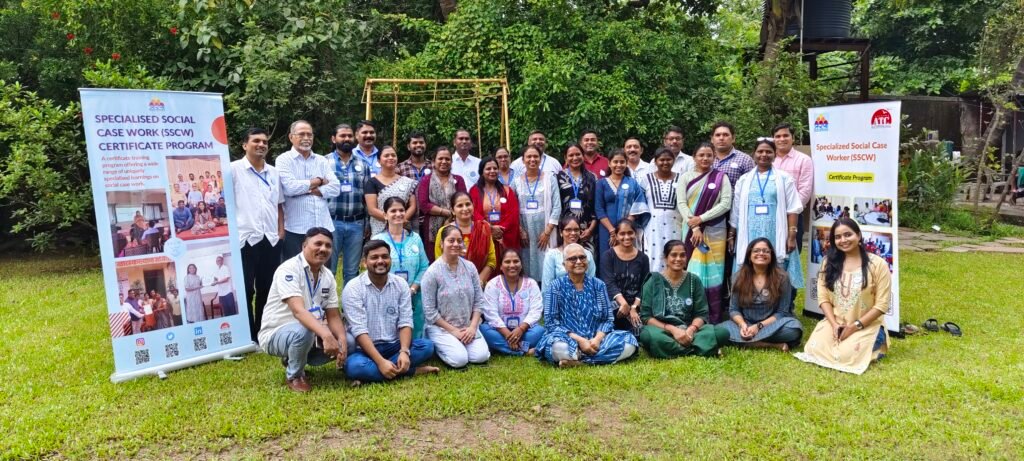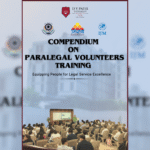A Journey Rooted in Experience

In 2020, we brought together insights from our three-decade-long journey in case work to design a curriculum on social case work. With this initiative, we sought to nurture the next generation of social case workers—those who wish to engage deeply and sensitively with child victims of sexual violence.
Our approach was simple yet ambitious: to engage young, passionate practitioners at the district level across Maharashtra and equip them with both the professional knowledge and emotional wisdom that meaningful case work demands.
Over the past five years, this program has steadily grown—reaching Ahmednagar, Nashik, Thane, Pune, Satara, Ratnagiri, and most recently, Palghar.
During a recent orientation for participants of the Specialised Social Case Workers (SSCW) Program in Palghar, I initiated a discussion that cut across all our work—the idea of safe spaces.
“What should we follow to ensure that our training feels like a safe space for all participants?” I asked.
What followed was a deeply thoughtful and inspiring conversation—one that reminded me that safety is not a condition we inherit, but something we consciously build together.
Starting a Conversation on Safety
The participants’ responses were rooted in empathy and awareness. Together, we arrived at a set of practices that define what it means to create and sustain a truly safe space:
- Maintain confidentiality – Discuss cases without revealing personal details. If someone shares something personal, it must remain within the group.
- Build trust within the group – Foster openness, honesty, and reliability in all interactions.
- Foster unity among participants – Abide by agreed rules and demonstrate solidarity for the cause of children.
- Practice transparency – Be clear, consistent, and truthful in communication. Avoid exaggeration or misrepresentation.
- Encourage non-hierarchical seating – Circular arrangements promote equality, inclusion, and active participation.
- Be gender-sensitive and sensitive toward individuals with special needs – Ensure everyone gets a chance to speak, respect different paces, and avoid domination in discussions.
- Treat everyone with respect and dignity – Prevent discrimination or preferential treatment. Ensure fairness irrespective of caste, religion, gender, or any other identity. No mockery, no bullying.
- Remain non-judgmental and aware of biases – Reflect on personal prejudices and ensure they don’t interfere with empathy or understanding.
- Uphold everyone’s right to express opinions – Respect differing viewpoints. Listen actively—verbally (“I understand”) and non-verbally (nodding, maintaining eye contact). Avoid sidelining others or speaking over them.
- Practice cultural humility – Strive to understand cultural values and contexts without relying on stereotypes.
- Ensure physical safety and accessibility – Provide first aid kits, check fire safety mechanisms, ensure safe transport in emergencies, address hazards such as exposed wires, make sanitary pads available, and keep doctor or hospital contacts ready.
Their responses reminded me that safety isn’t a checklist—it’s a living culture that must be nurtured with consistency, care, and self-reflection.
Principles That Build Safe Spaces
Safe spaces don’t emerge on their own—they are intentionally created, consistently practiced, nurtured, and collectively protected.
Setting the tone early makes all the difference. Before every session, facilitators must talk with participants about what a “safe space” means. Beginning with a safe space agreement invites participants to co-own the experience rather than simply attend it. This process deepens understanding and gives everyone a shared sense of responsibility.
Safe Spaces Are Intentionally Created
Facilitators can bring this idea to life through simple, participatory methods:
- Co-create and display the group’s safe space agreements on a flip chart or wall.
- Use role-play to explore boundaries, empathy, and respect.
- Encourage clear, non-jargon, non-discriminatory communication.
- Provide translation or interpretation for those who need it.
- Offer private channels for feedback, like a “suggestion or concern box,” for participants who might not feel comfortable speaking out.
Before addressing sensitive topics like violence or trauma, offer trigger warnings and allow participants to step out if needed. Sensitivity, after all, is not about silence—it’s about respect and preparedness.
Practices That Sustain Safe Spaces
Creating a safe space is only the first step; sustaining it requires ongoing care and conscious action.
Facilitators should ensure that support systems are available—such as having a counsellor or social worker on call for participants who might feel overwhelmed.
Ground rules for discussions around difficult subjects can help uphold empathy and balance:
- Listen to understand, not to reply.
- Disagree with ideas, not people.
- Step up, step back – those who speak often should pause, and quieter voices should be encouraged.
Celebration also plays a vital role. Appreciating contributions, acknowledging growth, and highlighting collective learning helps participants feel valued and included. The goal is not perfection—it’s participation.
When everyone feels seen and heard, the space itself becomes a teacher.
From Training Rooms to Communities
These aspiring case workers reminded me that the foundation of impactful social work lies not only in technical skill or theoretical knowledge, but in the capacity to create environments where dignity, trust, and inclusion can truly thrive.
As a natural next step, we will continue exploring how these same principles of safety and empathy are essential beyond training rooms—in the heart of case work itself. Building strong, professional, and compassionate relationships between case workers and clients begins with the same question we started with:
“What does it take for every person here to feel safe?”
Because when people feel safe, they can learn, grow, and heal—and that is where real change begins.




